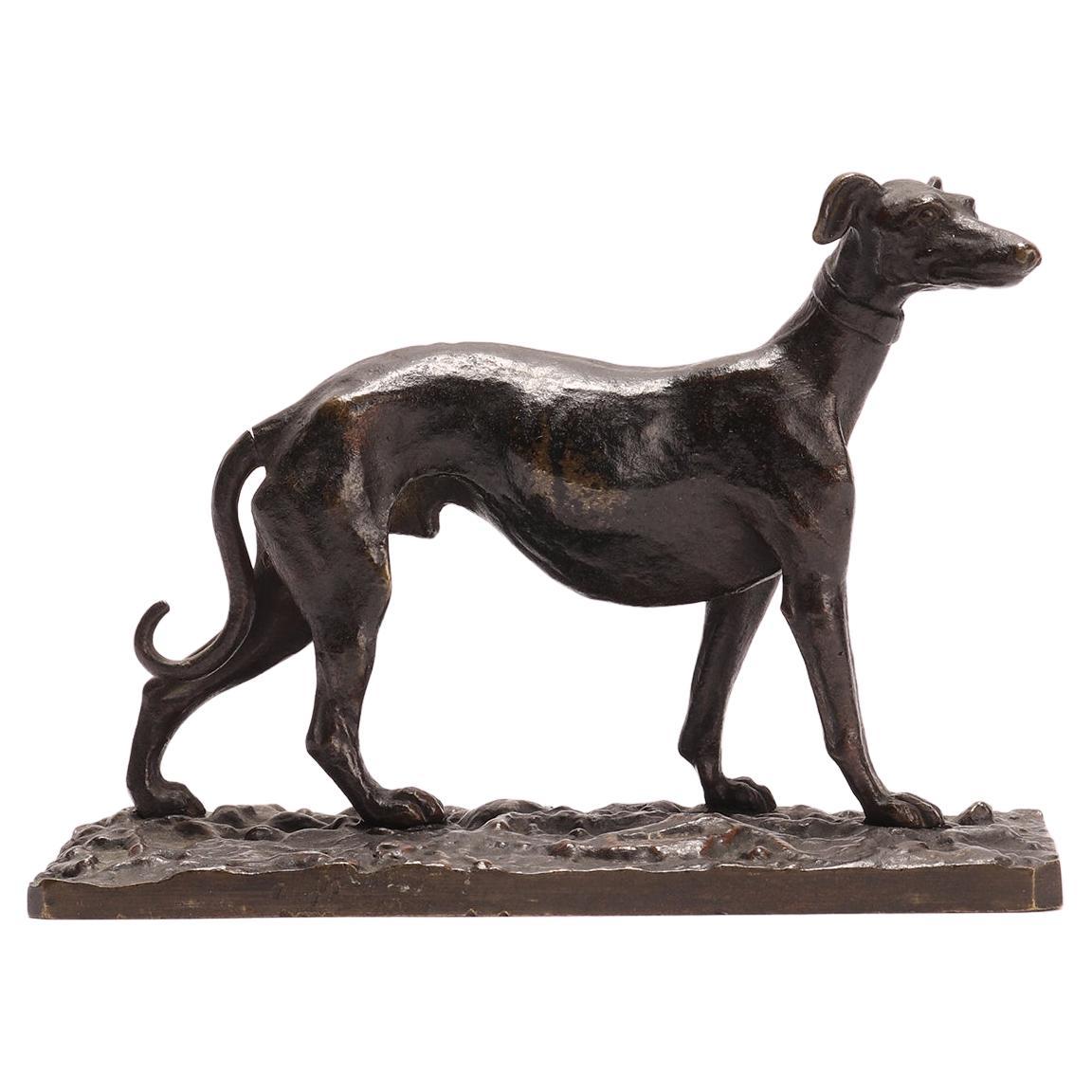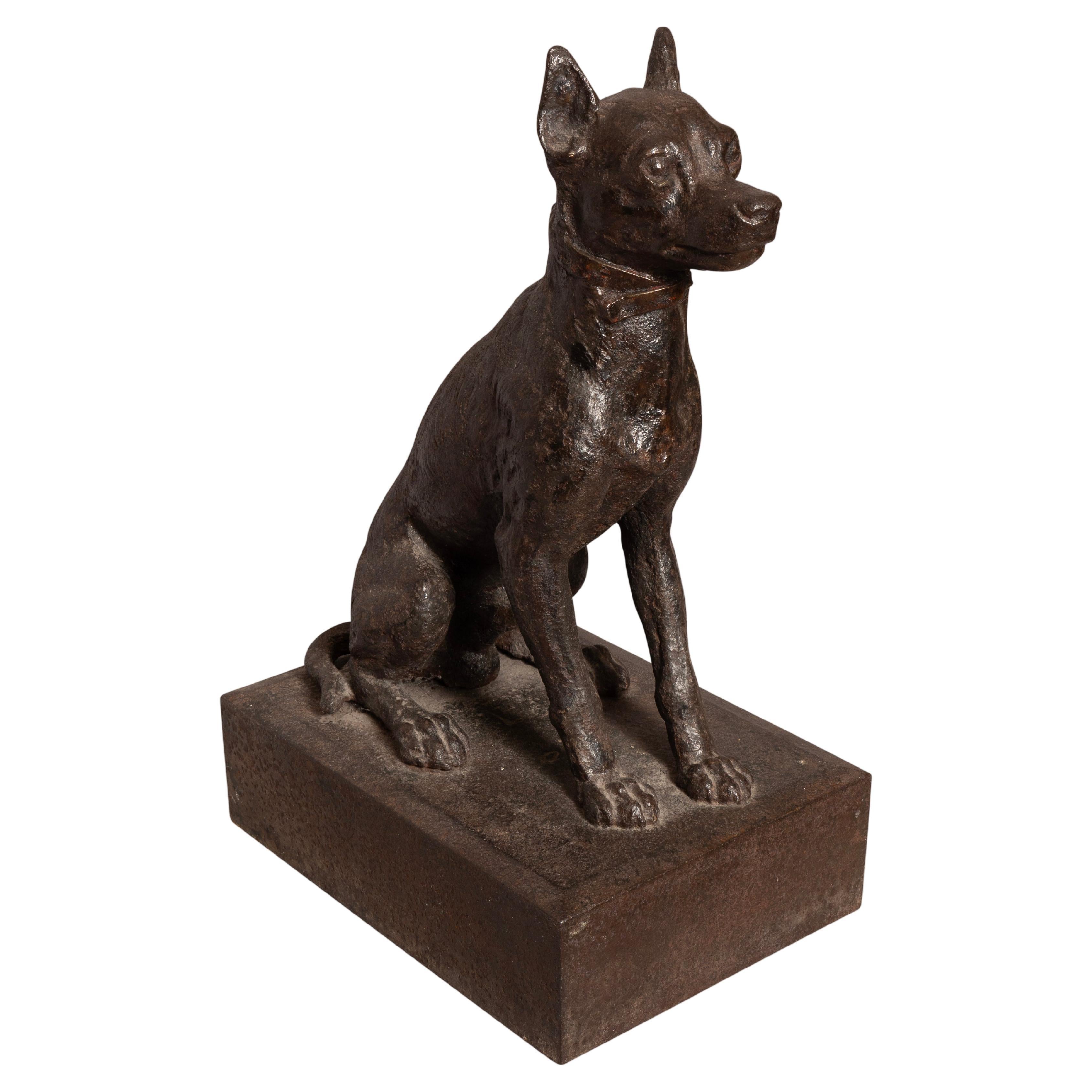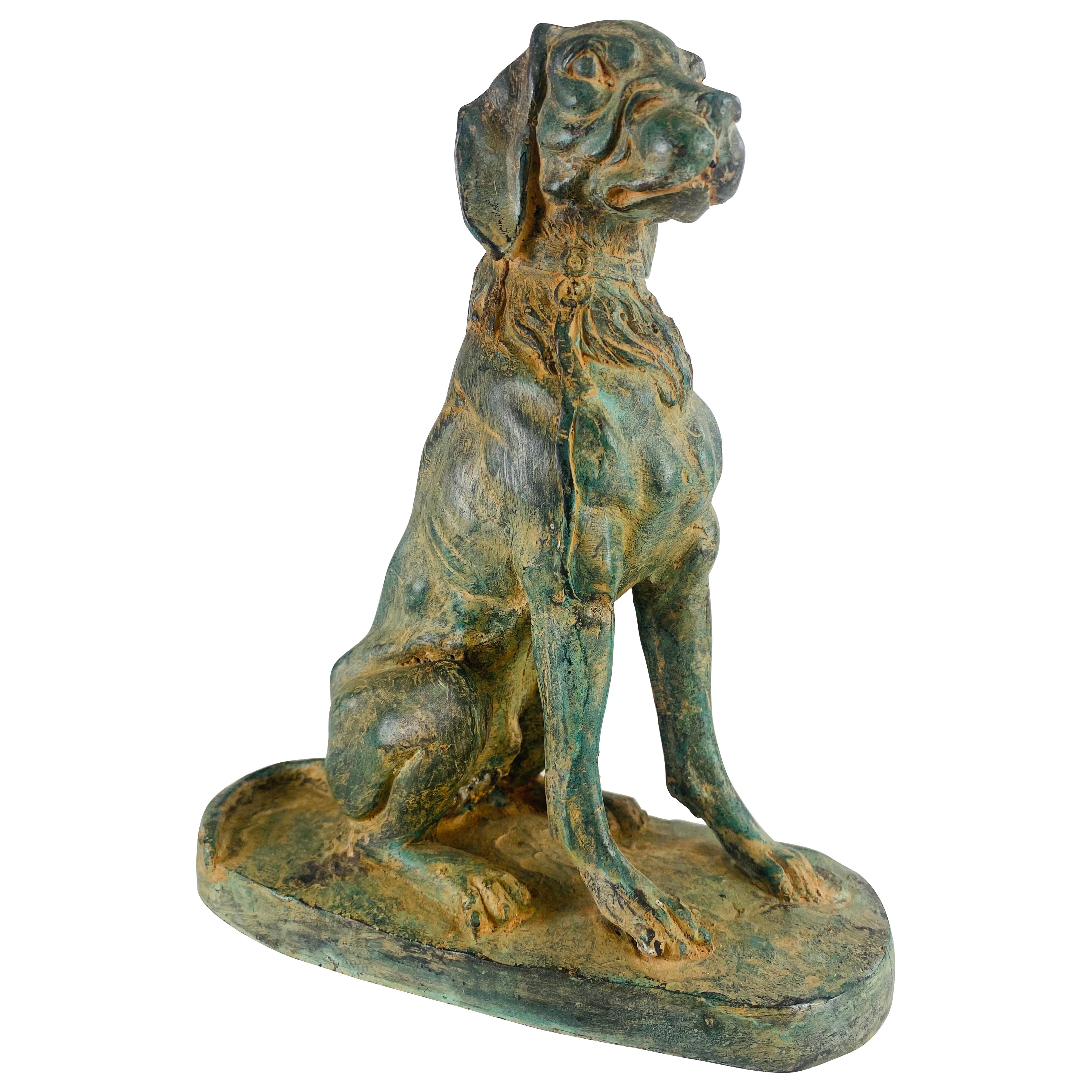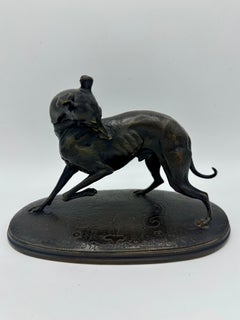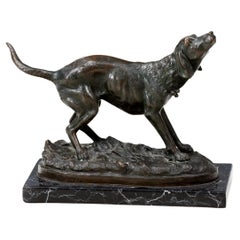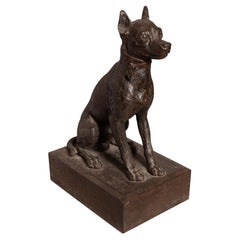Items Similar to A late 19th century bronze animalier figure of a seated hound
Want more images or videos?
Request additional images or videos from the seller
1 of 10
A late 19th century bronze animalier figure of a seated houndlate 19th century
late 19th century
$8,938.51
£6,500
€7,652.05
CA$12,239.82
A$13,608.34
CHF 7,123.15
MX$166,901.82
NOK 90,695.67
SEK 85,627.46
DKK 57,102.09
Shipping
Retrieving quote...The 1stDibs Promise:
Authenticity Guarantee,
Money-Back Guarantee,
24-Hour Cancellation
About the Item
A late 19th century bronze of a hound, seated on a naturalistic base, after Prince Paul Troubetzkoy. Incised to base 'Paolo Troubetzkoy 1893', with a dark brown patina.
Born in 1866 in Intra, on the shores of Lake Maggiore in Northern Italy, Troubetzkoy was the second-born child of the Russian Prince Pyotr Petrovich Troubetzkoy and the American singer Ada Winans. During his childhood, Troubetzkoy was exposed to popular artists and poets of the time, who used to meet at the grandiose Villa Ada (the Troubetzkoy family residence)on Lake Maggiore. Among the personalities of the Troubetzkoy family’s circle were the sculptor Giuseppe Grandi, the composer Alfredo Catalani and the painters Tranquillo Cremona and Daniele Ranzoni, well-known in Italy at that time. With the latter, Troubetzkoy had a long-lasting friendship.
From an early age, Paul displayed an extravagant personality and a fascination with the world around him. He favored independent thinking and was intolerant to rigorous study. These personality traits consolidated during his apprenticeship in Milan in 1884, with Donato Barcaglia and Ernesto Bazzaro. After a few months, he decided to leave the apprenticeship to work for himself and joined the Milanese artistic circles. He initially focused his art on small statuettes of animal subjects such as horses, dogs and elephants.
For the first time, in 1886, he exhibited one of his works, A Horse, at the Brera Academy. Towards 1890, he participated in numerous competitions for public monuments depicting, among others, Garibaldi, Dante and Amedeo VI of Savoia. In the same period, some of his works were acquired by museums in Italy and overseas, such as the Galleria Nazionale d’Arte Moderna in Rome and the Golden Gate Museum in San Francisco.
During his years of education in Italy, Troubetzkoy exhibited in important venues including Brera in Milan and the Koenig Galerie in Berlin. Following the death of his parents in 1898 and his brother Pierre moving to England, Troubetzkoy decided to move to Russia, where he stayed until 1906, with some intervals in France and Italy. These years were a turning point for the artist.
In 1899, he met Leo Tolstoy in Yasnaya Polyana. The encounter had a lifelong impact on Troubetzkoy. The artist, struck by Tolstoy’s humanitarian spirit, dramatically changed his views on life. Not only did he decide to stop eating food of animal origin, as witnessed by his work titled Corpse Eaters (today in the Collection of the Museo del Paesaggio), but also gradually changed his circle of close friends and beliefs.
In 1900 he participated in the Exposition Universelle in Paris with his Leo Tolstoy riding “Delire” (today at the Musée d’Orsay) which won him the Grand Prix. This success gave Troubetzkoy greater visibility and a huge boost to his career, gaining him an even wider recognition among the upper classes.
After his appointment as professor of sculpture at the Academy in Moscow, where he prompted his students to sculpt from nature, he was also recognized by Russians as the leader of the New Moscow School of sculpture. In 1901 he won the project-bid for the monument of Tsar Alexander III in St. Petersburg, which was completed in 1909. He also continued travelling to European capitals for exhibitions, such as Venice, Milan, Rome, Paris and finally Stockholm, the city where he meets his future wife, Elin Sundström.
In the meantime, he made himself known to the Russian Elite, by creating numerous busts of politicians and noblemen. It was during these times, and surrounded by his own social environment, that Troubetzkoy’s production became increasingly oriented towards aristocratic portraits, such as one depicting Prince Leo Galitzin.
After the outbreak of the Russian-Japanese war in 1905, Troubetzkoy decided to stay in Milan for a while, before moving definitively to Paris with his wife and his newborn son Pierre, who sadly passed away two years later. During these years in Paris, Troubetzkoy worked in his new studio in the city, where he stayed between 1906 and 1914. He became a member of the Société Nouvelle de Peintres et de Sculpteurs, chaired by Auguste Rodin. During this time, he was at the apex of his career, creating his finest portrait-statuettes, portraying prominent personalities, including his great friend, the poet and playwright George Bernard Shaw. In these same years the Vanderbilt family introduced Troubetzkoy to a prosperous American clientele.
Invited by Richard Milton Huntington in 1911, Troubetzkoy exhibited at the Hispanic and Numismatic Society in New York, presenting a wide selection of his works. In this year, he was also reunited with his brother Pierre, who in the meantime established himself in America.
With the outbreak of the First World War in 1914, Troubetzkoy decided to remain in America, where he stayed until 1921. Troubetzkoy found himself in a world very far removed from the aristocratic circles of Russia and Paris. This new life, new people and traditions, provided Troubetzkoy with fertile ground for his artistic practice.
In these years, he exhibited in numerous cities including San Francisco, Chicago, Boston, Cleveland and Washington. He was exposed to the most influential people in Hollywood, including film directors and producers as well as actors and tenors, such as Mary Pickford and Enrico Caruso. In 1919 he also won a competition to design the public sculpture of General Harrison Gray Otis in Los Angeles.
In 1921, Troubetzkoy decided to go back to Paris and to sojourn in the Ca’ Bianca in Suna, on his native Lake Maggiore, during summers. He also opened a new studio in Neuilly-sur-Seine, where the new and old clientele sat for Troubetzkoy’s new portraits. In 1923 he was in charge of the Monumento ai Cadutiof Pallanza (close to his residence): a bronze group dedicated to the fallen from war.
After many years in Paris, one last exhibition in 1931 at Colnaghi’s gallery in London and a failed marriage with Rhoda Muriel Somerville, Troubetzkoy moved definitively back to Italy in 1932. He continued exhibiting his works around Italy and briefly went to Egypt to portray the local upper class in the city of Cairo.
In this final phase of his career, he gradually moved from sculpture to oil painting and kept working in his house in Verbania, where he died in 1938. As stated by Troubetzkoy in his final wishes, his heirs donated all plaster casts left by the artist from his studio in Italy and Neuilly-sur-Seine to the Museo del Paesaggio in Verbania.
- Creation Year:late 19th century
- Dimensions:Height: 9.45 in (24 cm)Width: 7.68 in (19.5 cm)
- Medium:
- Movement & Style:
- After:Prince Paul Troubetzkoy (1866-1938, Russian)
- Period:
- Condition:
- Gallery Location:Bath, GB
- Reference Number:1stDibs: LU95214233112
About the Seller
5.0
Vetted Professional Seller
Every seller passes strict standards for authenticity and reliability
Established in 2002
1stDibs seller since 2015
37 sales on 1stDibs
Associations
The British Antique Dealers' AssociationLAPADA - The Association of Arts & Antiques DealersInternational Confederation of Art and Antique Dealers' Associations
- ShippingRetrieving quote...Shipping from: Bath, United Kingdom
- Return Policy
Authenticity Guarantee
In the unlikely event there’s an issue with an item’s authenticity, contact us within 1 year for a full refund. DetailsMoney-Back Guarantee
If your item is not as described, is damaged in transit, or does not arrive, contact us within 7 days for a full refund. Details24-Hour Cancellation
You have a 24-hour grace period in which to reconsider your purchase, with no questions asked.Vetted Professional Sellers
Our world-class sellers must adhere to strict standards for service and quality, maintaining the integrity of our listings.Price-Match Guarantee
If you find that a seller listed the same item for a lower price elsewhere, we’ll match it.Trusted Global Delivery
Our best-in-class carrier network provides specialized shipping options worldwide, including custom delivery.More From This Seller
View AllA large late 19th century French animalier bronze of a recumbent greyhound dog
By Christophe Fratin
Located in Bath, Somerset
A large late 19th century bronze figure of a recumbent greyhound after French animalier sculptor Christophe Fratin (1801-1864), with a warm brown patina on a rouge griotte marble base. Signed 'FRATIN' on collar.
Bronze length: 37cm
Base length: 41cm
Bronze height: 18cm
Total height: 22cm
Christophe Fratin was born in Metz in France in 1801. He first studied sculpture under Pioche in Metz under whom he honed his technical skills. He then became a pupil of the painter Theodore Gericault in Paris where he pursued his career as a sculptor.
Fratin first exhibited at the Paris Salon as early as 1831, where he showed ‘Fermer – An English Thoroughbred’. The popularity of Fratin’s sculpture in England had a significant impact on his career. His modelling style reflected his imaginative mind and sense of humour, particularly in his humorous modelling of bears.
Fratin was asked to sculpt life-size monuments for French cities, including his home town of Metz. At the Great Exhibition of 1851 in London he was considered the greatest animalier sculptor of the day. Fratin’s bronzes...
Category
1880s Naturalistic Figurative Sculptures
Materials
Bronze
A 19th century French animalier bronze of a greyhound
By Joseph Francois Victor Chemin
Located in Bath, Somerset
A late 19th century bronze figure of a greyhound, his front leg raised and head turned backwards as he grooms his coat. A finely detailed figure with a dark brown patina, mounted on ...
Category
Late 19th Century French School Figurative Sculptures
Materials
Bronze
A late 19th century bronze figure of a dog playing with a ball
By Arthur Waagen
Located in Bath, Somerset
A late 19th century bronze figure of a dog playing with a ball on a naturalistic base. Nice dark rich brown patina with slightly lighter rubbed area to lower side of base. Signed 'Wa...
Category
Late 19th Century Naturalistic Figurative Sculptures
Materials
Bronze
French Animalier bronze of an Italian greyhound dog with a fan
By Pierre Jules Mêne
Located in Bath, Somerset
Italian greyhound in bronze ‘Levrier a L’Eventail’ with black patination by French sculptor Pierre-Jules Mêne (1810-1879). The dog, facing right with an open fan lying on the carpet...
Category
Mid-20th Century Figurative Sculptures
Materials
Bronze
$1,643 Sale Price
20% Off
French 19th century Animalier bronze of Two Hares on a naturalistic base
By Alfred Dubucand
Located in Bath, Somerset
19th century bronze group of a standing and sitting hare by French animalier sculptor Alfred Dubucand (1823-1894). Finely detailed bronze with good dark brown patination. Signature '...
Category
Late 19th Century Naturalistic Figurative Sculptures
Materials
Bronze
Late 19th century Grand Tour bronze of the Dancing Faun
Located in Bath, Somerset
A 19th century 'Grand Tour' bronze figure of the Dancing Faun, standing on a bronze square plinth. The faun balances on his toes and pivots, his horned head raised, his hair wreathe...
Category
Late 19th Century Figurative Sculptures
Materials
Bronze
You May Also Like
20th Century Bronze Sculpture of a Hunting Dog
By Miguel Fernando Lopez 1
Located in Dublin 8, IE
20th Century Bronze Sculpture of a Hunting Dog by the artist Miguel Fernando López (Milo). Depicting an alert dog on a naturalistic base signed 'Milo'. Raised on a black marble plinth.
Category
20th Century Portuguese Animal Sculptures
Materials
Bronze
Bronze Sculpture of an Italian Grayhound Dog, France, 1880
Located in Milan, IT
Sculpture of an italian grayhound. Patinated bronze. The moved base is engraved with decorative motives. Original patina. France circa 1880.
Category
Antique Late 19th Century French Animal Sculptures
Materials
Bronze
Cast Iron Figure Of A Seated Dog
Located in Essex, MA
Large heavy seated male dog. Well cast with nice details.Seated on a plinth base.
Category
Antique Mid-19th Century European Animal Sculptures
Materials
Iron
Dog Bronze Foxhound Sculpture by Charles Rumsey
By Charles Cary Rumsey
Located in Brookville, NY
This beautiful bronze of a Foxhound is a study for what was to be a pair of larger ones used as a pair of Andirons outside fireplace at Harriman House in NYC. The artist, Charles Ru...
Category
1910s American Realist Figurative Sculptures
Materials
Bronze
Mid-century vintage bronze sculpture of a hunting dog
Located in Allentown, PA
This is a mid-century vintage sculpture of a hunting dog. This bronze sculpture has an age-appropriate green patina. This is an American made peace circa 1970.
Category
Vintage 1970s American Other Animal Sculptures
Materials
Bronze
Bronze Sculpture of a Hound
Located in Los Angeles, CA
A bronze hound sculpture on marble based.
Signed by French animalier sculptor Antoine-Louis Barye 1795-1875.
Category
19th Century Figurative Sculptures
Materials
Bronze
More Ways To Browse
Bronze Sculpture Seated
Seated Figure Sculpture
Bronze Figure After Antique
Bronze Figural Groups
Horse Sculptures Of 19th Century
Animalier Sculpture Bronze
French Animalier Sculpture
19th Century Bronze Horse Sculpture
Two Hounds
Prince Chair
Hound Sculpture
Antique Bronze Gate
French Bronze Elephant
Horse Riding Sculpture
Plaster Horse
Plaster Cast Busts
Japanese Seated Figure
Italian Bust Plaster

